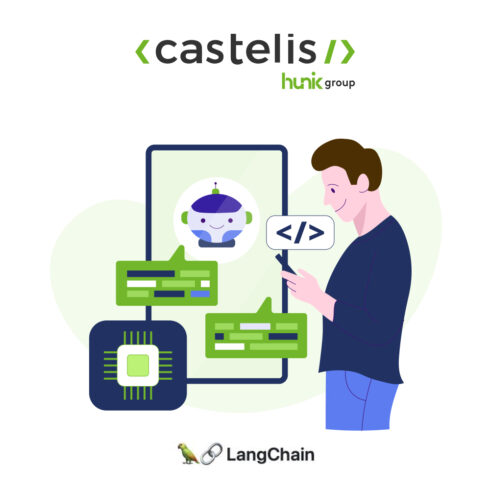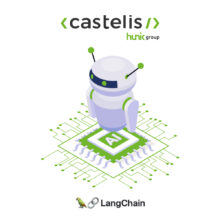
Building with Langchain: developing advanced AI applications
In the rapidly evolving landscape of artificial intelligence, Langchain is emerging as a crucial tool for developers and technologists looking to harness the potential of large-scale language models (LLMs). This revolutionary framework offers a robust platform for integrating, manipulating and deploying generative AI functionality in a multitude of applications.
- What is Langchain?
- An overview for developers
- Langchain: at the heart of major language models
- Unpacking Langchain: architecture and components
- Langchain’s core modules and their interconnections
- Functioning and management of modular components
- Advanced interaction with Langchain
- Creating Langchain chains for complex tasks
- Using Agents and Memory for more intelligent AI
- Langchain in practice: technical use cases
- Building high-performance chatbots with Langchain
- Managing large, heterogeneous document databases (RAG)
- Integrating Langchain into data ecosystems
- Connecting Langchain with external databases and APIs
- Using Langchain to process structured and unstructured data
- The challenges of prompt engineering with Langchain
- Designing effective LLM prompts
- Tips and best practices for prompt engineering
- Debugging and monitoring Langchain applications
- Using LangSmith for tracing and evaluation
- Performance monitoring and optimization techniques
- Extending and customizing Langchain’s capabilities
- Creating customized Langchain modules
- Adapting Langchain to specific usage scenarios
- Security and ethics when using Langchain
- Security practices for Langchain-based applications
- Ethical considerations and responsibility in generative AI
- Langchain, a pillar in the AI ecosystem and its future
What is Langchain?
Langchain is a software framework designed specifically to facilitate and optimize the development of LLM-based applications. As a modular solution, Langchain enables developers to integrate various language models into their projects smoothly and efficiently. It bridges the gap between the complexity of advanced language models and practical applications, offering unprecedented flexibility in AI development.
An overview for developers
For developers, Langchain is an invaluable toolbox. Whether it’s creating sophisticated chatbots, developing personalized recommendation systems or analyzing complex textual data, Langchain provides the tools and functionality needed to bring these projects to fruition. Its ability to work in harmony with LLMs such as GPT-3 opens up innovative possibilities in generative artificial intelligence, making the development process more intuitive and accessible.
Langchain: at the heart of major language models
At the heart of Langchain lies its ability to work harmoniously with LLMs like GPT-3. This compatibility enables developers to take full advantage of the power of these advanced AI models. Langchain not only facilitates interaction with these models, but also enables seamless integration into existing development environments, paving the way for unprecedented innovation in generative AI.
Unpacking Langchain: architecture and components
Langchain stands out for its innovative architecture and modular components, which together form a solid foundation for the development of advanced AI applications. Let’s take a closer look at Langchain’s core components and how they work together.
Langchain’s founding modules and their interconnection
At the heart of Langchain are several key modules, each playing a specific role in processing AI tasks. These modules include :
- Model I/O: This module acts as an interface with language models, managing inputs and outputs, and facilitating communication between LLMs and other Langchain components.
- Data Connection: This is the component that enables Langchain to connect and interact with external data sources, making it possible to integrate application-specific data into the AI process.
- Chains: Chains in Langchain are sequences of automated operations or calls that can be configured to perform complex tasks using LLMs.
- Agents: Agents enable chains to choose which tools and operations to use according to specific guidelines, making applications more intelligent and adaptive.
- Memory: This module retains the state of the application between chain executions, enabling continuity and contextualization of interactions and operations.
These modules are designed to work together seamlessly, allowing great flexibility and customization according to developers’ specific needs.
Modular component operation and management
Each Langchain component is designed to be modular, which means it can be used independently or in combination with others. This modularity enables developers to customize their AI applications, by choosing the specific components needed for their project.
Managing these modular components is facilitated by an intuitive user interface and well-designed APIs. Developers can easily add, remove or modify components in their AI processing chains, offering great flexibility in application development. What’s more, Langchain’s modular nature enables easy integration with other systems and tools, making generative AI applications more powerful and more integrated into existing technology ecosystems.
Advanced interaction with Langchain
Langchain transforms the way developers interact with large-scale language models (LLMs), introducing advanced interaction capabilities. At Castelis, they enable developers to build sophisticated, personalized AI systems capable of handling complex tasks and delivering enriched, intelligent user experiences. Let’s find out how Langchain facilitates the creation of complex chains and the use of its Agents and Memory modules for smarter AI.
Creating Langchain chains for complex tasks
Langchain chains are a key feature of the framework, enabling developers to combine multiple processing steps into single, automated sequences. These chains can include various operations, such as data analysis, text generation, or even integration with other systems or APIs.
To create a Langchain chain, our developers start by defining the various components required – such as language templates, data processing functions, or database connectors. Then they configure the sequence of operations, determining how data flows between these components and how information is processed at each stage. This method makes it possible to handle complex AI tasks, from automated question answering to real-time analysis of large volumes of data.
Using Agents and Memory for smarter AI
Two of Langchain’s most powerful modules are Agents and Memory. Agents act as coordinators within chains, deciding which tools to use and how to use them based on high-level directives. They make Langchain-based applications more flexible and adaptive, enabling dynamic decisions to be made according to the user’s context and objectives. Thus, when the developed application is connected to third-party tools, the Agents automatically determine which APIs to call for which uses from the proposed catalog.
The Memory module, for its part, offers a memory capability that preserves state and context between different executions of a chain. This is particularly useful for applications such as chatbots, where maintaining the context of a conversation is crucial for natural, consistent interactions. With Memory, Langchain applications can remember previous interactions, improving the quality and relevance of generated responses.
Langchain in practice: technical use cases
Langchain, with its flexibility and power, finds practical applications in many technical fields. Whether it’s improving customer engagement through sophisticated chatbots, or efficiently managing large amounts of data, Langchain is proving to be an indispensable tool for developers and engineers.
Building high-performance chatbots with Langchain
One of Langchain’s most impressive use cases is building advanced chatbots. Thanks to its ability to integrate LLMs and handle complex queries, Langchain makes it possible to create chatbots that go far beyond standard scripted responses. These chatbots can understand and respond to nuanced requests, offering a much richer and more natural user experience.
Developers can use Langchain strings to manage the conversation flow, integrating capabilities such as sentiment analysis, contextual understanding, and even personalized responses based on interaction history. Langchain’s modularity also makes it easy to integrate new functionalities into the chatbot, such as connecting to external databases to provide up-to-date information, or performing specific tasks in response to user commands.
Management of large, heterogeneous databases (RAG)
Another impressive use case for Langchain is the management of large, heterogeneous document bases, thanks in particular to Retrieval-Augmented Generation (RAG) technology. With Langchain, developers can create systems capable of browsing, analyzing and synthesizing information from large sets of documents. Castelis developers have the opportunity to implement projects of this type for a number of our corporate clients.
This includes the ability to work with unstructured data in a variety of formats, such as free text, reports, graphs and even visuals, and transform them into structured, usable information. Langchain can be used to develop content analysis tools, recommendation systems, or intelligent search assistants capable of providing precise, relevant answers drawn from a vast knowledge base.
Integrating Langchain into data ecosystems
Langchain proves particularly powerful when integrated into complex data ecosystems. This integration enables developers to take full advantage of structured and unstructured data in their AI applications.
Connecting Langchain with external databases and APIs
One of Langchain’s strengths is its ability to connect easily with external databases and APIs. This connectivity is essential for applications that require access to up-to-date information, or for those that interact with other systems.
To integrate Langchain with databases, developers can use Langchain’s Data Connection module, which provides interfaces for interacting with SQL or NoSQL databases. This module enables Langchain-based applications to retrieve, process and store data in these databases, which is crucial for applications such as recommendation systems or personal assistants that require continuous access to up-to-date data.
When it comes to integration with external APIs, Langchain offers the flexibility to connect to a variety of web services. Developers can create Langchain chains that include API calls to enrich the capabilities of their applications, such as integrating online payment services into an e-commerce chatbot, or accessing weather services for planning applications.
Using Langchain to process structured and unstructured data
Langchain also excels at processing structured and unstructured data. Langchain can be used to extract and analyze structured data, such as that stored in relational databases, integrating it into broader AI processes. This enables complex analyses to be carried out, automated reports to be generated and data-driven insights to be provided.
For unstructured data, such as text, images or audio files, Langchain enables developers to build processing pipelines that convert this data into formats that can be exploited by LLMs. For example, Langchain can be used to extract relevant information from voluminous text documents, to analyze sentiment in customer feedback, or even to process visual data by converting it into textual descriptions.
The challenges of prompt engineering with Langchain
Prompt engineering, or the art of designing efficient prompts for large-scale language models (LLMs), is a crucial aspect of using Langchain. This skill is essential for maximizing the performance of LLM-based applications. Castelis teams experience this daily on generative AI projects involving Langchain, seeking to optimize the results proposed by the various applications developed according to their context of use.
Designing effective LLM prompts
Prompts, in the context of LLMs, are instructions or questions formulated to elicit a specific response from the model. A well-designed prompt should be clear, direct and designed to guide the model towards producing the most useful and accurate response possible.
With Langchain, developers can experiment with different types of prompts to determine which work best for their specific applications. This may involve trial and error to refine the wording, length and style of the prompt. For example, a prompt for a customer service chatbot might be designed to encourage responses that offer concise, direct solutions, while a prompt for a creative content generation tool might be more open and suggestive.
Tips and best practices for prompt engineering
Based on our feedback, here are some tips and best practices for prompt engineering with Langchain:
- Clarity and precision: Formulate clear prompts that communicate exactly what you expect from the model. Avoid ambiguity that could lead to imprecise or irrelevant answers.
- Contextualization: Include sufficient context in the prompt to guide the model. This may include background information or details of the type of response expected.
- Prompt length: Test different prompt lengths. Sometimes a shorter prompt is more effective, while in other cases a more detailed description may produce better results.
- Use prompt templates: Use pre-designed prompt templates and customize them to your application’s specific needs. These templates can be used as a starting point for developing more specific prompts.
- Iterative feedback: Use feedback to refine your prompts. LLMs can sometimes respond in unexpected ways, so it’s important to continually adjust your prompts according to the results obtained.
- Diversify approaches: Don’t be afraid to experiment with different approaches in your prompts. Variations in tone, style or structure can have a significant impact on model performance.
As you may have noticed when chatting with Chat-GPT, if you express yourself with a rich, precise vocabulary and mastered syntax, he’ll respond with the same demand for clarity, expertise and level of language. On the other hand, if you’re rushed, imprecise, use hackneyed terms and approximate or false turns of phrase, his response will be equally lacking in quality. Prompt engineering, on the other hand, generally follows the same rules.
Debugging and monitoring Langchain applications
Debugging and monitoring are crucial steps in developing and maintaining the quality of Langchain-based applications. These processes not only identify and correct errors, but also optimize application performance and efficiency.
Using LangSmith for tracing and evaluation
LangSmith is a Langchain-integrated tool designed specifically for tracing and evaluating LLM-based applications. It provides an intuitive interface for visualizing the flow of data through the various components of the application, making it easy to identify points of failure or bottlenecks in processing.
Using LangSmith, developers can follow the path taken by a query through the various Langchain modules, from input to output. This enables them to understand how the various components interact and how data is transformed throughout the process. LangSmith is particularly useful for diagnosing problems in complex chains, where several operations follow one another.
Performance monitoring and optimization techniques
Continuous monitoring and performance optimization are essential to maintain the reliability and efficiency of Langchain applications. Here are some key techniques for achieving this, tested and approved by the Castelis development teams:
- Logging: Set up a comprehensive logging system to record activity and errors in your application. This includes LLM responses, requests sent, and errors or exceptions captured.
- Performance analysis: Use performance analysis tools to monitor response times, query success rates, and other key performance indicators (KPIs). This will help you identify areas requiring improvement.
- Automated testing: Implement automated testing to regularly check the stability and reliability of your application. This can include integration tests to check interactions between different Langchain components.
- Resource optimization: Monitor resource usage (such as memory and CPU) to ensure that your application makes efficient use of system capacity. Optimize code and configurations to improve performance and reduce resource consumption.
- User feedback: Incorporate a mechanism for collecting user feedback. User feedback can provide valuable insights for improving user experience and application quality.
Extending and customizing Langchain’s capabilities
By leveraging Langchain’s ability to be extended and customized, developers can create AI applications that not only meet specific needs, but are also perfectly aligned with the unique goals and challenges of their projects.
Create customized Langchain modules
One of the most powerful aspects of Langchain is the ability to create custom modules. These custom modules can be designed to add unique functionality or to enhance the framework’s existing capabilities. For example, a developer could create a specific module for advanced data analysis in a particular field, such as finance or healthcare, or a module to integrate a new natural language processing API.
Creating custom modules generally involves the following steps:
- Requirements Definition: Identify the specific functionality the module needs to provide and how it fits into the existing Langchain ecosystem.
- Design and Development: Develop the module in line with Langchain’s principles of modularity and interoperability. This may include programming new interfaces, setting up data connectors, or implementing new algorithms.
- Testing and integration: Carefully test the module to ensure its reliability and efficiency, then integrate it into your Langchain application.
Adapting Langchain to specific use scenarios
Langchain is designed to be adaptable to a wide variety of usage scenarios. This adaptability allows developers to customize Langchain’s behavior to exactly match the requirements of their specific projects.
To adapt Langchain to a particular usage scenario, developers can :
- Configure Chains: Adjust Langchain chains so that they process data in a way that conforms to the requirements of the scenario. This may involve modifying the order of operations, integrating custom modules, or configuring data processing parameters.
- Customize LLM Interactions: Adjust LLM prompts and responses so that they are optimized for the specific needs of the application, such as more detailed answers in a customer support tool, or creative suggestions in a content generation tool.
- Integrate Specific Data Sources: Connect Langchain to specific databases or information sources that are relevant to the usage scenario, such as medical databases for a healthcare application.
Security and ethics in the use of Langchain
The use of advanced AI technologies such as Langchain raises important security and ethical issues. It is crucial for developers to take these aspects into account to ensure responsible and safe use of Langchain. This not only helps to protect users and data, but also builds trust in applications based on generative AI.
Security practices for Langchain-based applications
Security is an essential aspect when developing applications using Langchain, especially when dealing with sensitive or personal data. Here are some recommended security practices:
- Data management: Be vigilant when managing data, especially sensitive data. This means ensuring that data is encrypted during storage and transfer, and that access is strictly controlled and monitored.
- Authentication and authorization: Implement robust authentication and authorization systems to control access to applications and data. Use strong authentication methods and ensure that permissions are correctly assigned.
- Tracking and logging: Set up a tracking and logging system to record activities and transactions. This makes it easier to detect anomalies and respond rapidly to security issues.
- Security testing: Carry out regular security audits and tests, such as penetration tests, to identify and correct potential vulnerabilities.
Ethical considerations and responsibility in generative AI
In addition to the technical aspects, it is essential to address the ethical issues associated with the use of LLMs and generative AI.
- Transparency: Be transparent about how LLMs are used and how decisions are made. Users need to be aware that they are interacting with an AI system and understand how it works.
- Bias and fairness: Work actively to identify and minimize bias in language models. This involves monitoring generated responses for potential bias, and using diverse and balanced datasets for model training.
- Privacy: Ensure that data use complies with privacy laws, such as the GDPR. Obtain explicit consent for the collection and use of personal data.
- Liability: Establish clear guidelines on liability in the event of misuse or AI-related problems. This includes setting up response mechanisms in the event of errors or problems caused by AI systems.
Langchain, a pillar in the AI ecosystem and its future
Langchain has rapidly established itself as an invaluable asset in the world of artificial intelligence, providing us developers with a powerful and flexible platform for harnessing the capabilities of language models at scale.
Looking to the future, Langchain is well positioned to continue playing a key role in the evolution of AI. With constant innovation in the LLM field and increasing demand for more sophisticated AI applications, Langchain or future alternatives are likely to remain at the forefront, facilitating access to these advanced technologies and opening the door to new possibilities.
Langchain is not just a tool for today; it’s a foundation for tomorrow’s innovations in artificial intelligence. For developers and technicians, working with Langchain means not only solving today’s problems, but also shaping the future of generative AI technology.
Need more information on IA et web tools for your company or specific web development? Contact us, Castelis’ custom development and data experts are at your disposal.
Voir plus de Actualités

Why Microsoft Sentinel is Essential for Cyber Threat Management: A Practical Guide for CIOs

Top best practices to improve email security with DMARC

Cloudflare Zaraz Guide: Manage your third-party scripts at the Edge for better web performance
